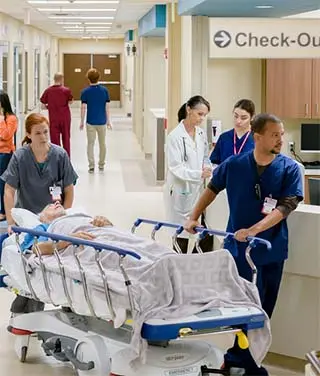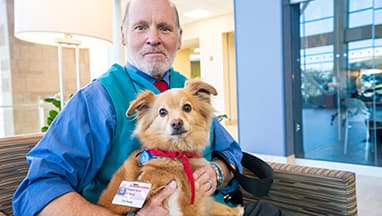Emergency Care
If you have a medical emergency, call 911 or go to the closest emergency department. See a list of Presbyterian emergency department locations below.

In the emergency department, we diagnose and treat illnesses and injuries that can be life-threatening and require immediate medical attention. Emergency medicine providers have special training to provide advanced life-saving care such as:
Surgical procedures
Trauma resuscitation (restart breathing and heart)
Advanced cardiac life support for problems such as heart attack
Advanced airway management to help you breathe
After treatment, you may need to be admitted to the hospital or you may be sent home and advised to seek follow up care with another provider.
Sometimes you're not sure of the best place to get the care you need. Here are some guidelines to help:
Go to an emergency department for conditions such as:
Chest pain
Any sudden or severe pain
Difficulty breathing
Head injuries
Sudden changes in vision
Difficulty speaking
Sudden confusion or dizziness
Suicidal feelings
Coughing up or throwing up blood
Major broken bones, such as a leg
Severe diarrhea or throwing up
Severe bleeding
Abdominal pain
Active labor
Go to urgent care for conditions such as:
Sprains and strains
Sore throats, coughs, colds or the flu
Ear or sinus infection
Allergy flare-ups
Mild asthma
Minor broken bones, such as a finger
Minor cuts that may need stitches
Nausea
We offer urgent care, pediatric urgent care and 24/7 Urgent and Emergency Care locations in the Albuquerque metro area and in Santa Fe. View our Urgent Care locations
Presbyterian provides emergency care at the following locations:
1100 Central Ave. SE in Albuquerque
8300 Constitution Ave. NE in Albuquerque
Presbyterian Rust Medical Center
2400 Unser Blvd. SE in Rio Rancho
Presbyterian Santa Fe Medical Center
4801 Beckner Road in Santa Fe
211 Sudderth Dr. in Ruidoso
Presbyterian Española Hospital
1010 Spruce St. in Española
1202 Highway 60 West in Socorro
Plains Regional Medical Center
2100 N. Martin Luther King Jr. Blvd. in Clovis
Dr. Dan C. Trigg Memorial Hospital
301 E. Miel de Luna in Tucumcari
PRESNow 24/7 in Albuquerque on Coors Blvd
4515 Coors Blvd NW in Albuquerque
PRESNow 24/7 in Albuquerque on Isleta Blvd
3436 Isleta Blvd SW in Albuquerque
PRESNow 24/7 in Albuquerque on Paseo Del Norte Blvd
6400 Paseo Del Norte Blvd NE in Albuquerque
PRESNow 24/7 in Albuquerque on Menaul Blvd 7400 Menaul Blvd. NW in Albuquerque
You'll sign in and be asked your name and some basic information. We will ask you about your medical problem. Depending on your specific reason for care, you may have a wait time. The order in which patients are seen is based on how severe their illness or injury is. Staff at the emergency department are unable to provide estimated waiting times.
After you have been registered, you will be called up to the triage area where a nurse or other staff member will take your temperature and other vital signs. You will also be asked some questions about your medical emergency. You will be sent back to the waiting area until you are called for your medical screening exam.
An emergency room provider will perform a medical screening exam to determine what kind of care you need. Your provider will discuss any tests or treatment you might need and will talk to you about whether your condition is a medical emergency.
If your condition is an emergency, you may be treated in the emergency department or admitted to the hospital for further care. In the case of an emergency-level illness or injury, you will be treated and stabilized regardless of your ability to pay. If you do not have insurance, our patient navigators will work with you to help see if you qualify for financial assistance or insurance to pay for your emergency department visit.
If your provider determines your condition is not an emergency, you will meet with an on-site patient navigator who will make an appointment for you to visit a primary care clinic or refer you to urgent care, depending on the type of injury or illness you have.
If you wish to be treated in the emergency department for a non-emergency illness or injury, you must pay for services you receive during your visit. Many insurance plans will not pay for care or services in the emergency department if it is determined the patient's condition is not a medical emergency.
Patient navigators are available to work with you to see if you qualify for financial assistance or a payment plan. These services are available regardless of whether your condition is determined to be a medical emergency or can be treated in another setting.



